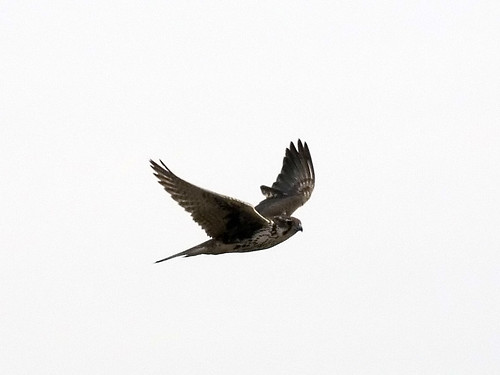A prairie falcon, Falco mexicanus.
This photo was taken on Christmas Eve in north-central Kansas.
Image: David A. Rintoul.
As long as you send images to me (and I hope it will be for forever), I shall continue to share them with my readership. My purpose for posting these images is to remind all of us of the grandeur of the natural world and that there is a world out there that is populated by millions of unique species. We are a part of this world whether we like it or not: we have a choice to either preserve these species or to destroy them in search of short-term monetary gains. But if we decide to destroy these other life forms, the least we can do is to know what we are destroying by learning that they exist. If you have a high-resolution digitized nature image (I prefer JPG format) that you'd like to share with your fellow readers, feel free to email it to me, along with information about the image and how you'd like it to be credited.
.


Well, you didn't bite Prof Lupton's English 102 students, but they bit you - now you feel you need to justify the beautiful pictures of nature we've always enjoyed. Ok, I'm probably readiing too much into this, and I should apologize.
I like Grrlscientist's revised statement below the nature images. I think it has become necessary to remind everyone of the reasons for species protection, habitat conservation, etc... I've done a fair bit of volunteer stream survey work in my region, and occasionally that has extended to leading day outings with local high school science students. It's always enjoyable to work with them, but I'm quite shocked by how little contact most kids have had with nature. Quite a few have never held a frog. Almost none have ever picked up a crayfish, let alone seen one in a river. Most have no idea that dragonflies spend the majority of their lives as aquatic naiads before emerging to become airborne. Some panic and scream if they see a spider or a bee anywhere around them. I really worry about that -- I mean *REALLY* worry -- because these kids are going to be taking on the responsibility of protecting the natural world when I and other conservation minded people are gone. What will happen if the next generation doesn't gain some appreciation for the rapidly diminishing natural world? I think we already know the answer. I believe we've got to do more.... try harder... to increase awareness of the natural world before it's too late. Btw, at the end of a day of field work with a science class, it always feels good to know that at least 20 or so kids are going home with about ten times as much knowledge about stream ecology than they had that very morning.
Bev has it exactly right; people in this country (and not just the kids!) are becoming incredibly isolated from the natural world. This can lead to an apathy toward other species and their needs that will make it ever more difficult when we need to protect habitats.
Posting a picture of a beautiful animal like a Prairie Falcon is a good thing. It is no substitute for getting them out there to show them that animal in its element, slicing through a winter wind with grace and elegance, but it is a good start, and I'm glad that this blog makes that effort, for all of us.